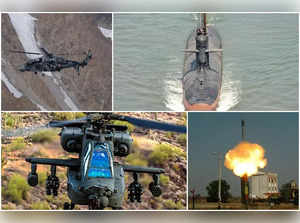 Agencies
AgenciesStrengthened Indigenous Defence Manufacturing
Saraswat noted that currently, 60% of India's arms and ammunition are domestically produced, reflecting a substantial increase in indigenous manufacturing. He mentioned that major corporate entities like the Adani Group, Tata Group, and L&T are now manufacturing radar systems and guns within the country, further bolstering India's self-reliance in defence production.
Decrease in Import Dependency
Despite the rise in India's arms requirements, Saraswat pointed out that the ratio of imports to the overall defence requirement is decreasing. He cited a recent report by the Swedish think tank SIPRI, which stated that India's arms imports increased by 4.7% between 2014-2018 and 2019-2023, indicating a decreasing reliance on imports.
"Indian defence capabilities in the last 10 years have gone up substantially," Saraswat told PTI. He pointed out that despite the rise in India's arms requirements, the ratio of imports to the overall defence requirement is decreasing. He cited a recent report by the Swedish think tank SIPRI, which stated that India's imports increased by 4.7% between 2014-2018 and 2019-2023, indicating a decreasing reliance on imports.
Robust Power Capacity
Addressing concerns about potential power cuts due to heatwaves, Saraswat assured that India's installed capacity of around 452 gigawatts is sufficient to meet the country's power requirements. He expressed confidence that there would not be significant power cuts this summer due to capacity constraints.
Promising Future for Defence Sector
According to a report titled "India Defence" by Nomura, India's defence sector presents a substantial ordering prospect of nearly USD 138 billion from FY24 to FY32 for companies involved in defence production and technology advancement. The report forecasts that India's defence capital expenditure is set to reach close to 37% of the total budget by FY30, indicating significant growth opportunities in the sector.
Supportive Government Policies
The Indian government is actively supporting the defence sector through favourable policy reforms, incentives, and initiatives to promote indigenous manufacturing and technology development. This support is expected to drive the share of defence capital outlay to 37% of the total defence budget in FY30, up from 26% in FY24.
Growth Opportunities Across Segments
The report highlights promising prospects in various segments of the defence sector. Defence aerospace presents a significant opportunity amounting to USD 50 billion, while defence shipbuilding offers a potential of USD 38 billion. Investments in missiles, artillery, and gun systems are projected to reach USD 21 billion, reflecting India's efforts to enhance its artillery and missile capabilities.
Positive Outlook for Defence Companies
The report also outlines a positive outlook for shares of companies like Hindustan Aeronautics (HAL) and Bharat Electronics. HAL's shares have surged by 156% to Rs 3877, while Bharat Electronics shares have risen by 109% to Rs 227 over the past year. This growth reflects investor confidence in these companies amidst supportive government policies aimed at bolstering indigenous manufacturing and technology development in the defence sector.
The Indian government's active support for the defence industry and its emphasis on indigenous manufacturing and technology development are expected to create a favourable environment for companies operating in this sector. With a growing emphasis on expanding the global presence of India's defence industry through exports and collaborations, companies specializing in defence manufacturing and technology development are well-positioned to leverage export opportunities and broaden their market reach.
(With inputs from Agencies)
Download The Economic Times News App to get Daily Market Updates & Live Business News.
Subscribe to The Economic Times Prime and read the ET ePaper online.
Read More News on
Download The Economic Times News App to get Daily Market Updates & Live Business News.
Subscribe to The Economic Times Prime and read the ET ePaper online.









 Get Unlimited Access to The Economic Times
Get Unlimited Access to The Economic Times
